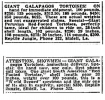Brenda and I just got back last night from a busy vacation. Able to visit my daughter and family in Alabama, but also took time to allow us to do some work with the Galapagos project while in the SE US. We were able to visit with some amazing Galapagos tortoises. Got lessons on drawing blood for genetic testing and microchipping some tortoises. Also took time for some legal paperwork and setting up bank account for the group we have created.
A small group – including a handful of TortoiseForum members – have created the Galapagos Tortoise Alliance. The GTA is dedicated to working for the better understanding and improvement of the husbandry and the long-term survival of the Galapagos Tortoise. Seeing what is happening in the world with these magnificent giants and this iconic species, it seems clear to us that the long-term survival of this species is going to come from dedicated private keepers. With the last official tortoise that was taken from the Galapagos islands in 1959, the number the world has to work with is severely limited and is declining. Species have not been defined and separated, and what little successful breeding has occurred has resulted in mostly hybrid tortoises – and now we face the extreme rarity of pure species that exist outside of the Galapagos Islands. On the islands, local land use and outdated husbandry is combining to continue to threaten the tortoises that remain in their native environment.
Our vacation allowed us to take some next steps in expanding our learnings and better understanding the tortoises and people we have the great privilege to work with in this endeavor.
Walking the acres of this property, you start to see some distinctive domes in the distance. Free roaming such a large overgrown place, they stay amazingly hidden until they see or hear you and then start to emerge hoping for a treat.
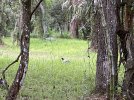
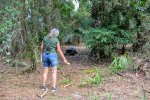
Pretty soon more are coming and you better have some treats ready!
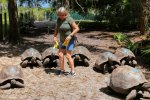
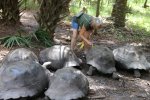
While busy feeding and taking pictures, we didn't notice some had decided not to wait their turn and found the bucket full of bananas even though we had it tucked away in the golf cart!
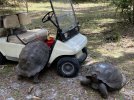
They love to sit in mud holes they continually form and enlarge when it rains. But many are even more interested in affectionate petting and here Brenda has had this large male come straight out of the mud for attention. This large male is a pure Chelonoidis vicina Brenda gladly obliged with the love and totally didn't care about all the mud!
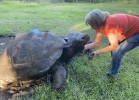
Here's a Chelonoidis becki reaching for a treat. Notice the more saddleback shape to this species. They are actually intermediate in morphology to the dome and saddleback type species.

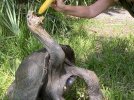
Another large male emerged from the mud for attention, then treats. You can see the mud hole on the right with a smaller female still in it. They spend a lot of time soaking in the water/mud. They will often even spend the entire night sleeping there.
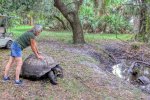
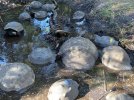
Here's a pure Chelonoidis porteri. She is Mobray and is the dam (mother) of several of my tortoises. She came from the Galapagos Islands with the Townsend Expedition in 1928. At 100 years old plus, she is one of the best producers in the breeding program. Paired with another pure C porteri - Herb the Sire (father of many of mine), Mobray and Herb form a keystone part of the future of this species. C porteri is listed as the largest tortoise species in the world.
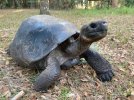
In another area, Brenda is feeding some pure Chelonoidis microphyes here. Younger females.

We found this huge male resting under man made cover. Seeing Brenda, the only thing he wanted was attention! Only after petting did he show interested in a banana treat.
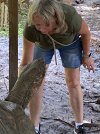
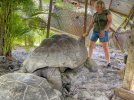
We also took time to do a little work and learn the techniques of drawing blood and microchipping the tortoises. For our project, we are indentifying and verifying the exact lineage of the tortoises. So we need to draw blood for the DNA testing and matching to verify. As we draw blood, we also then microchip (insert a PIT tag) for postitive ID on that individual and attach the PIT tag number to the blood vial that goes off to the lab.
Here I am drawing blood from a C porteri born in 2020. Now about 2500g. (the red looking stains are betadine.) We use an abundance to sterilize the area liberally. The tortoise rarely even bleeds at all for neither the blood draw or the pit tagging.
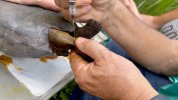
Next I make a very small incision in the left hind leg. The microchip needle is rather large. It is easier to make a scalpel incision first in the tough skin.
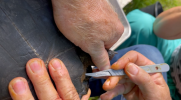
Then insert the needle into the incision and insert the PIT tag into the thigh muscle area. The incision does not even bleed with the tough skin of these tortoises.

Next, check the reading for the PIT tag now that it is sucessfully inserted into the tortoise's thigh muscle.
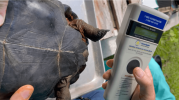
Finally we take pictures of the tortoise from all angles to keep as records and cross check noting any identifying unique characteristics the tortoise may have. Setting the tortoise back in its pen they all started to graze on grass within minutes of being placed back - apparently totally unaffected by the process!
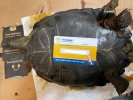

An absolutely amazing experience and just the early stages of truly epic journey. And a thank you to the TortoiseForum that was the vehicle that actually allowed us to find each other to make the Galapagos Tortoise Alliance a reality.
More to come in the months and years ahead.
A small group – including a handful of TortoiseForum members – have created the Galapagos Tortoise Alliance. The GTA is dedicated to working for the better understanding and improvement of the husbandry and the long-term survival of the Galapagos Tortoise. Seeing what is happening in the world with these magnificent giants and this iconic species, it seems clear to us that the long-term survival of this species is going to come from dedicated private keepers. With the last official tortoise that was taken from the Galapagos islands in 1959, the number the world has to work with is severely limited and is declining. Species have not been defined and separated, and what little successful breeding has occurred has resulted in mostly hybrid tortoises – and now we face the extreme rarity of pure species that exist outside of the Galapagos Islands. On the islands, local land use and outdated husbandry is combining to continue to threaten the tortoises that remain in their native environment.
Our vacation allowed us to take some next steps in expanding our learnings and better understanding the tortoises and people we have the great privilege to work with in this endeavor.
Walking the acres of this property, you start to see some distinctive domes in the distance. Free roaming such a large overgrown place, they stay amazingly hidden until they see or hear you and then start to emerge hoping for a treat.


Pretty soon more are coming and you better have some treats ready!


While busy feeding and taking pictures, we didn't notice some had decided not to wait their turn and found the bucket full of bananas even though we had it tucked away in the golf cart!

They love to sit in mud holes they continually form and enlarge when it rains. But many are even more interested in affectionate petting and here Brenda has had this large male come straight out of the mud for attention. This large male is a pure Chelonoidis vicina Brenda gladly obliged with the love and totally didn't care about all the mud!

Here's a Chelonoidis becki reaching for a treat. Notice the more saddleback shape to this species. They are actually intermediate in morphology to the dome and saddleback type species.


Another large male emerged from the mud for attention, then treats. You can see the mud hole on the right with a smaller female still in it. They spend a lot of time soaking in the water/mud. They will often even spend the entire night sleeping there.


Here's a pure Chelonoidis porteri. She is Mobray and is the dam (mother) of several of my tortoises. She came from the Galapagos Islands with the Townsend Expedition in 1928. At 100 years old plus, she is one of the best producers in the breeding program. Paired with another pure C porteri - Herb the Sire (father of many of mine), Mobray and Herb form a keystone part of the future of this species. C porteri is listed as the largest tortoise species in the world.

In another area, Brenda is feeding some pure Chelonoidis microphyes here. Younger females.

We found this huge male resting under man made cover. Seeing Brenda, the only thing he wanted was attention! Only after petting did he show interested in a banana treat.


We also took time to do a little work and learn the techniques of drawing blood and microchipping the tortoises. For our project, we are indentifying and verifying the exact lineage of the tortoises. So we need to draw blood for the DNA testing and matching to verify. As we draw blood, we also then microchip (insert a PIT tag) for postitive ID on that individual and attach the PIT tag number to the blood vial that goes off to the lab.
Here I am drawing blood from a C porteri born in 2020. Now about 2500g. (the red looking stains are betadine.) We use an abundance to sterilize the area liberally. The tortoise rarely even bleeds at all for neither the blood draw or the pit tagging.

Next I make a very small incision in the left hind leg. The microchip needle is rather large. It is easier to make a scalpel incision first in the tough skin.

Then insert the needle into the incision and insert the PIT tag into the thigh muscle area. The incision does not even bleed with the tough skin of these tortoises.

Next, check the reading for the PIT tag now that it is sucessfully inserted into the tortoise's thigh muscle.

Finally we take pictures of the tortoise from all angles to keep as records and cross check noting any identifying unique characteristics the tortoise may have. Setting the tortoise back in its pen they all started to graze on grass within minutes of being placed back - apparently totally unaffected by the process!


An absolutely amazing experience and just the early stages of truly epic journey. And a thank you to the TortoiseForum that was the vehicle that actually allowed us to find each other to make the Galapagos Tortoise Alliance a reality.
More to come in the months and years ahead.
